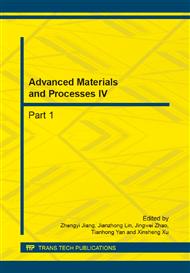p.261
p.266
p.270
p.277
p.284
p.288
p.292
p.296
p.302
The Study on Growth Interface of Floating Zone Silicon Crystal
Abstract:
The shape and stability of growth interface have significant influence on the floating zone (for short FZ) silicon crystal. During the growth of crystal cone, growth interface reversal will happen due to the change of cooling mechanism, which makes crystal growth unstable. This impact will be more obvious for crystal with large diameter. During the growth of crystal body, with the crystal diameter increasing, the growth interface curvature and thermal stress both increase, which is easy to result in dislocation and even crack of the crystal. So this experiment mainly studied how to solve the instability problem due to interface inversion and how to reduce interface curvature. In the experiment we compared the growth interface shape of 6 inches <111> FZ silicon, at different pull speed, and find that during the growth of crystal cone, interface inversion can finish ahead with higher pull speed, and during the growth of crystal body, interface curvature decreased (interface depth≈32 mm) with lower pull speed ( υ=2.5mm/min) and higher rotate speed, to increases the chances for success of crystal growth.
Info:
Periodical:
Pages:
284-287
Citation:
Online since:
September 2014
Authors:
Price:
Сopyright:
© 2014 Trans Tech Publications Ltd. All Rights Reserved
Share:
Citation:


